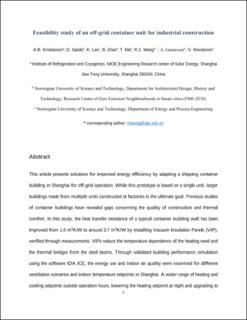| dc.contributor.author | Kristiansen, A. B. | |
| dc.contributor.author | Satola, Daniel | |
| dc.contributor.author | Lee, Kate | |
| dc.contributor.author | Zhao, B. | |
| dc.contributor.author | Ma, Tao | |
| dc.contributor.author | Wang, Ruzhu | |
| dc.contributor.author | Gustavsen, Arild | |
| dc.contributor.author | Novakovic, Vojislav | |
| dc.date.accessioned | 2021-02-25T11:08:35Z | |
| dc.date.available | 2021-02-25T11:08:35Z | |
| dc.date.created | 2020-07-02T09:05:44Z | |
| dc.date.issued | 2020 | |
| dc.identifier.issn | 2210-6707 | |
| dc.identifier.uri | https://hdl.handle.net/11250/2730346 | |
| dc.description.abstract | This article presents solutions for improved energy efficiency by adapting a shipping container building in Shanghai for off-grid operation. While this prototype is based on a single unit, larger buildings made from multiple units constructed at factories is the ultimate goal. Previous studies of container buildings have revealed gaps concerning the quality of construction and thermal comfort. In this study, the heat transfer resistance of a typical container building wall has been improved from 1.0 m2K/W to around 3.7 m2K/W by installing Vacuum Insulation Panels (VIP), verified through measurements. VIPs reduce the temperature dependence of the heating need and the thermal bridges from the steel beams. Through validated building performance simulation using the software IDA ICE, the energy use and indoor air quality were examined for different ventilation scenarios and indoor temperature setpoints in Shanghai. A wider range of heating and cooling setpoints outside operation hours, lowering the heating setpoint at night and upgrading to triple glazed windows were found to be the most economic energy saving measures. Combined with roof rainwater harvesting, the possibility of achieving near self-sufficiency of water and electricity in the suburbs of Shanghai shows promise in the quest for a higher degree sustainable living. | en_US |
| dc.language.iso | eng | en_US |
| dc.publisher | Elsevier | en_US |
| dc.relation.uri | https://www.sciencedirect.com/science/article/pii/S2210670720305564?dgcid=coauthor&fbclid=IwAR3xoSMxbqKXvdeuZz-6emqt7aHaCup5VgRuWQA4tjiyL1uQQrJ0K-86bCk | |
| dc.rights | Attribution-NonCommercial-NoDerivatives 4.0 Internasjonal | * |
| dc.rights.uri | http://creativecommons.org/licenses/by-nc-nd/4.0/deed.no | * |
| dc.title | Feasibility study of an off-grid container unit for industrial construction | en_US |
| dc.type | Peer reviewed | en_US |
| dc.type | Journal article | en_US |
| dc.description.version | acceptedVersion | en_US |
| dc.source.volume | 61 | en_US |
| dc.source.journal | Sustainable cities and society | en_US |
| dc.identifier.doi | 10.1016/j.scs.2020.102335 | |
| dc.identifier.cristin | 1818189 | |
| dc.relation.project | Norges forskningsråd: 257660 | en_US |
| dc.description.localcode | © 2020. This is the authors’ accepted and refereed manuscript to the article. Locked until 20/6-2022 due to copyright restrictions. This manuscript version is made available under the CC-BY-NC-ND 4.0 license http://creativecommons.org/licenses/by-nc-nd/4.0/ | en_US |
| cristin.ispublished | true | |
| cristin.fulltext | postprint | |
| cristin.qualitycode | 1 | |

